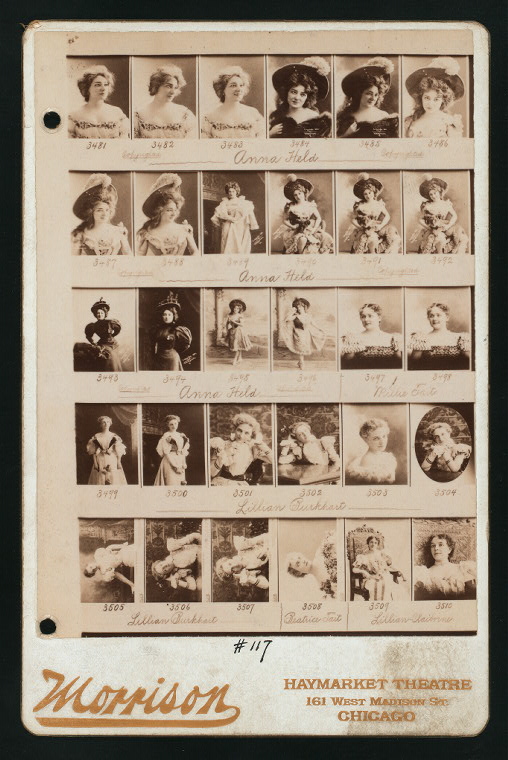Archives
Contact Strips and Head Shots
One of the themes of the exhibition Head Shots is the selection process through which performers view options and chose their headshots. Like the photographs themselves, the selection process has changed with technology. Performers waited for the invention of reproducible negatives before they adopted photographic headshots—access to negatives and duplicates at any time were the selling points for the photographic studios (proclaimed on their promotional cabinet mounts). How did that work and what did that access mean for actors and their agents?
Contact sheets provided the mechanism. They are direct positive prints from the negative, the immediate image on film. Digital photos lack them entirely, as did Polaroids. Most of the contact sheets in the LPA collections are 8’ x 10” photo paper printed with 16 – 20 rectangles or square (depending on the camera) with sprockets bearing negative numbers. More on modern format contact sheets and alternative selection tools in future posts.
Pre-1900 contacts, however, have strips of images, thumbnail size or smaller. In the exhibition, we provide a magnifying sheet so that visitors can see detail. Because of their size and fragility, they had to be adhered to a sturdier backing for safe keeping. The Billy Rose Theatre Division has an oversized scrapbook filled with these strips, which was fascinating but too fragile to display (MWED +++ 97-32 RBS). It was maintained by Benjamin Falk’s New York City studio, and covers 1893-1895 images, but it is likely that Falk and every other studio maintained shelves of these volumes. This blog’s key image is a very rare example of contact strips mounted on a cabinet photography mount. It features 3 rows of images of the musical theater superstar Anna Held, with two of actress Lillian Burkhardt, and was mounted by the Morrison Studio, at Haymarket Theatre, Chicago. This convenient format was most likely used because Held was traveling. The Morrison Studio connection was probably through her manager Florenz Ziegfeld, Jr., whose home and early career was in Chicago. Held was an important actress, singer and rag-inspired song-writer in early 20th century musical theater and it is unfortunate that her career has been subsumed to her place in the Ziegfeld biography. But, for a good study of the Ziegfeld partnership, see Eve Golden’s Anna Held and the Birth of Ziegfeld’s Broadway.
The artifact also points out the congruence of the photo districts and theater districts in Chicago, as in most American and European cities. In pre-1900 New York, both were in the area between Madison Square and Union Square. This remained the area for photo studios, supplies and labs, although the theaters soon moved uptown to make Times Square the new (and still current) theater district.
Read E-Books with SimplyE
 With your library card, it's easier than ever to choose from more than 300,000 e-books on SimplyE, The New York Public Library's free e-reader app. Gain access to digital resources for all ages, including e-books, audiobooks, databases, and more.
With your library card, it's easier than ever to choose from more than 300,000 e-books on SimplyE, The New York Public Library's free e-reader app. Gain access to digital resources for all ages, including e-books, audiobooks, databases, and more.
If you don’t have an NYPL library card, New York State residents can apply for a digital card online or through SimplyE (available on the App Store or Google Play).
Need more help? Read our guide to using SimplyE.

Comments
My great regards for your
Submitted by Allan (not verified) on August 13, 2015 - 7:02am